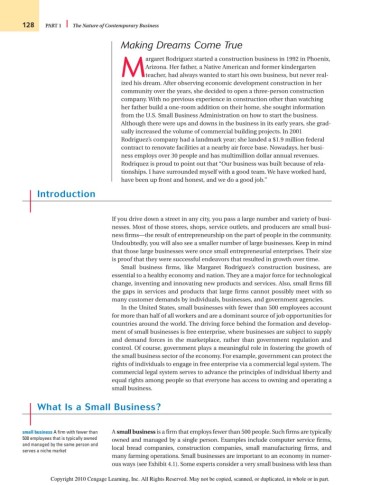Page 154 - Introduction to Business
P. 154
128 PART 1 The Nature of Contemporary Business
Making Dreams Come True
argaret Rodriguez started a construction business in 1992 in Phoenix,
Arizona. Her father, a Native American and former kindergarten
Mteacher, had always wanted to start his own business, but never real-
ized his dream. After observing economic development construction in her
community over the years, she decided to open a three-person construction
company. With no previous experience in construction other than watching
her father build a one-room addition on their home, she sought information
from the U.S. Small Business Administration on how to start the business.
Although there were ups and downs in the business in its early years, she grad-
ually increased the volume of commercial building projects. In 2001
Rodriguez’s company had a landmark year; she landed a $1.9 million federal
contract to renovate facilities at a nearby air force base. Nowadays, her busi-
ness employs over 30 people and has multimillion dollar annual revenues.
Rodriquez is proud to point out that “Our business was built because of rela-
tionships. I have surrounded myself with a good team. We have worked hard,
have been up front and honest, and we do a good job.”
Introduction
If you drive down a street in any city, you pass a large number and variety of busi-
nesses. Most of those stores, shops, service outlets, and producers are small busi-
ness firms—the result of entrepreneurship on the part of people in the community.
Undoubtedly, you will also see a smaller number of large businesses. Keep in mind
that those large businesses were once small entrepreneurial enterprises. Their size
is proof that they were successful endeavors that resulted in growth over time.
Small business firms, like Margaret Rodriguez’s construction business, are
essential to a healthy economy and nation. They are a major force for technological
change, inventing and innovating new products and services. Also, small firms fill
the gaps in services and products that large firms cannot possibly meet with so
many customer demands by individuals, businesses, and government agencies.
In the United States, small businesses with fewer than 500 employees account
for more than half of all workers and are a dominant source of job opportunities for
countries around the world. The driving force behind the formation and develop-
ment of small businesses is free enterprise, where businesses are subject to supply
and demand forces in the marketplace, rather than government regulation and
control. Of course, government plays a meaningful role in fostering the growth of
the small business sector of the economy. For example, government can protect the
rights of individuals to engage in free enterprise via a commercial legal system. The
commercial legal system serves to advance the principles of individual liberty and
equal rights among people so that everyone has access to owning and operating a
small business.
What Is a Small Business?
small business A firm with fewer than A small business is a firm that employs fewer than 500 people. Such firms are typically
500 employees that is typically owned owned and managed by a single person. Examples include computer service firms,
and managed by the same person and
serves a niche market local bread companies, construction companies, small manufacturing firms, and
many farming operations. Small businesses are important to an economy in numer-
ous ways (see Exhibit 4.1). Some experts consider a very small business with less than
Copyright 2010 Cengage Learning, Inc. All Rights Reserved. May not be copied, scanned, or duplicated, in whole or in part.

